Dell XPS 15 L502x: Now with Sandy Bridge
by Jarred Walton on April 20, 2011 1:10 AM ESTBetter Midrange Graphics, But Still Midrange
If you just look at the model number, you might get the idea that the GeForce GT 540M is a significant upgrade from the other GT 420M found in the original XPS 15. Unfortunately, that’s the problem with model numbers; the reality is the only key differences are in clock speeds (and power requirements). Both the GT 420M and the GT 540M sport the same 96 CUDA cores and a 128-bit DDR3 memory interface; however, the GT 420M comes clocked at 500/1000MHz on the core/shaders while the GT 540M sports a 672/1344MHz clock. The memory also runs at 900MHz instead of 800MHz. The result is up to 34% faster computational performance but only 12.5% more memory bandwidth. That means in practice the L502x should beat the L501x by 10 to 35% in gaming performance, depending on where the bottleneck happens to lie—though it could be higher on games that depend more on the CPU.
Here are the full results at our low, medium, and high default settings. Twenty-four graphs for your viewing pleasure; please, take your time.
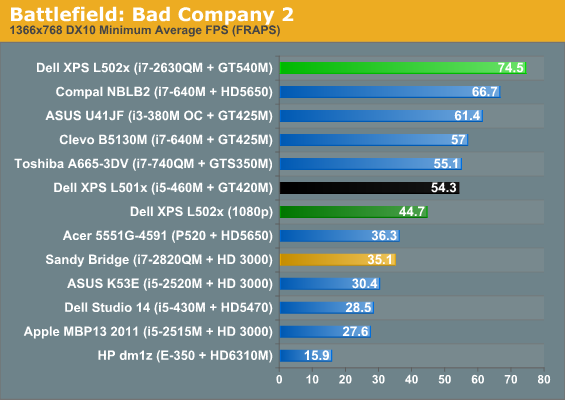

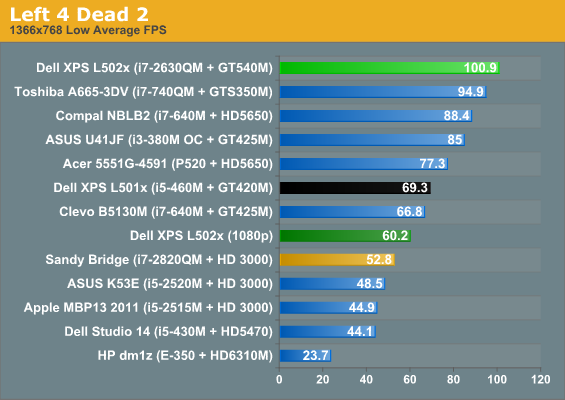
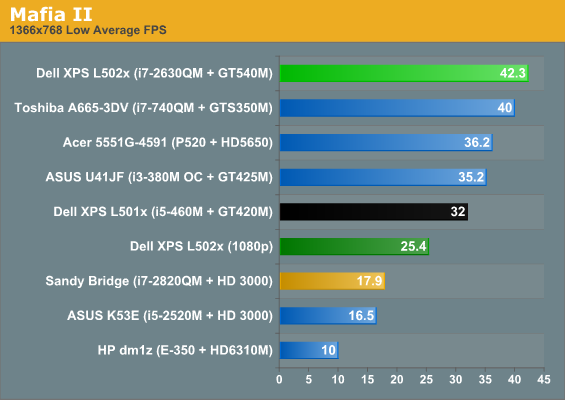
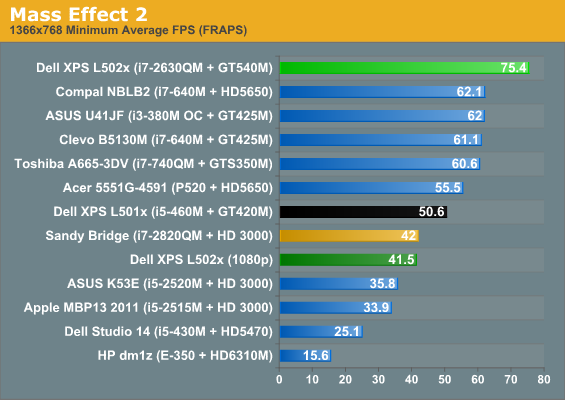
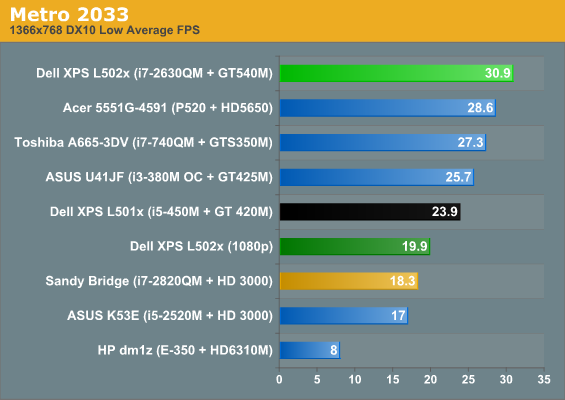
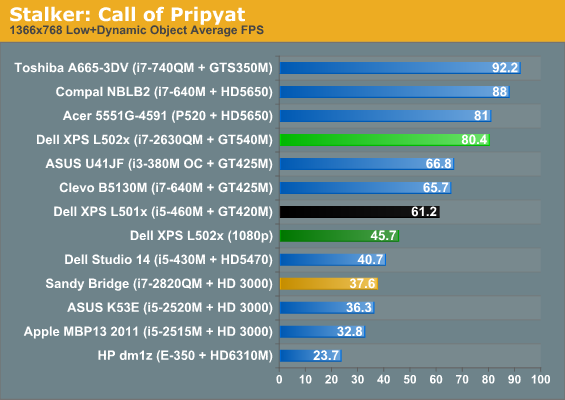
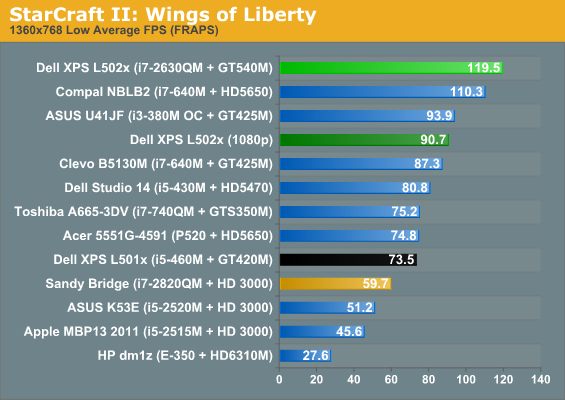

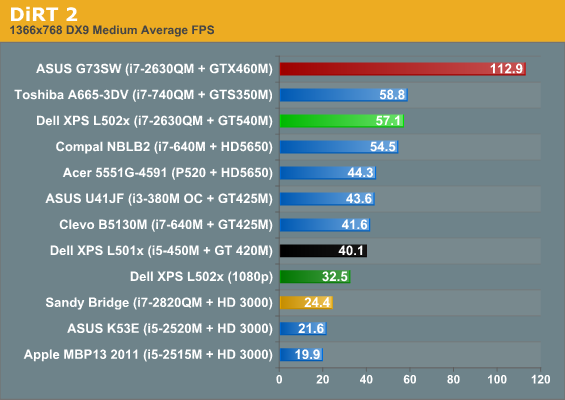
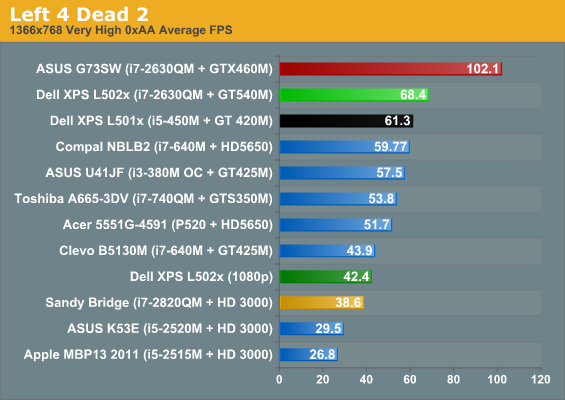
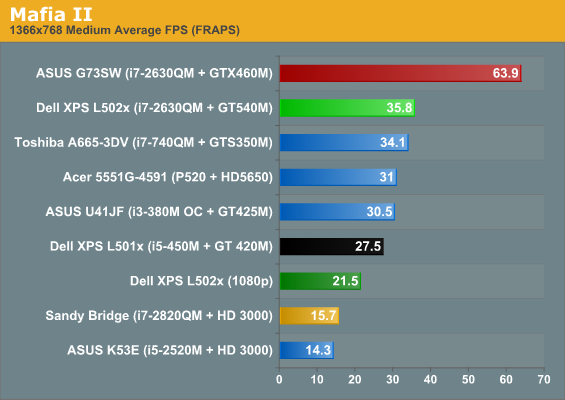
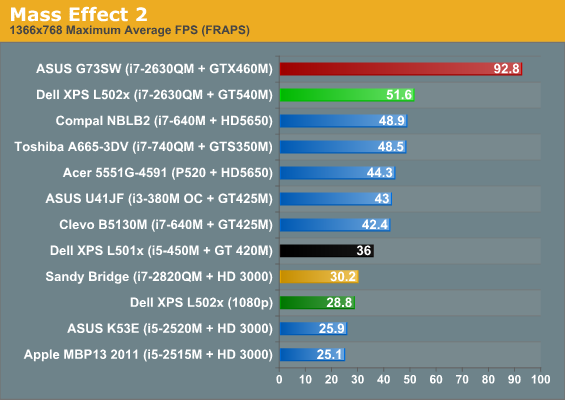
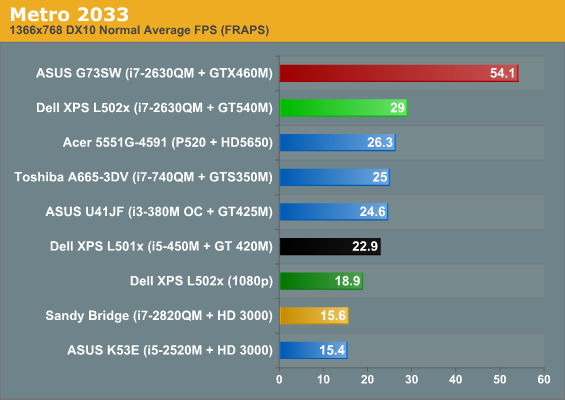
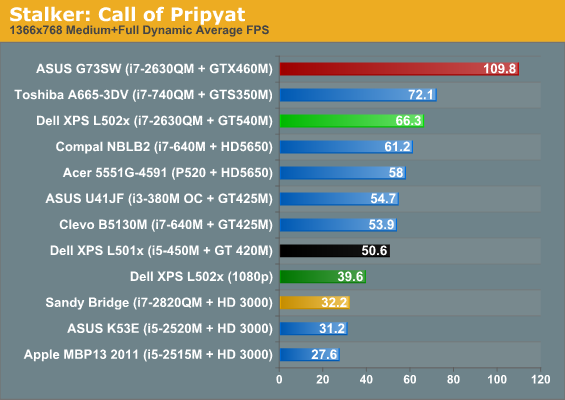
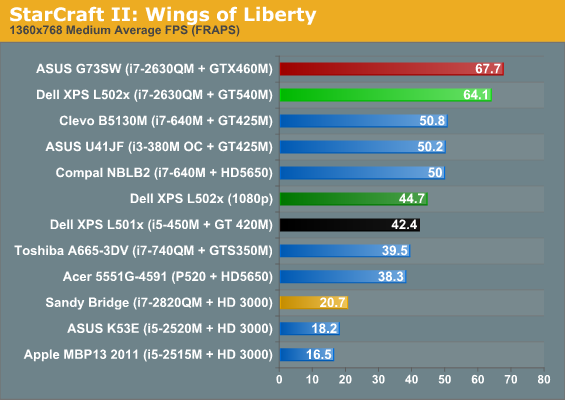
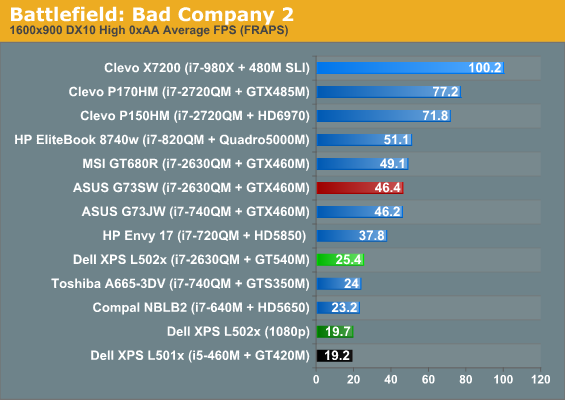
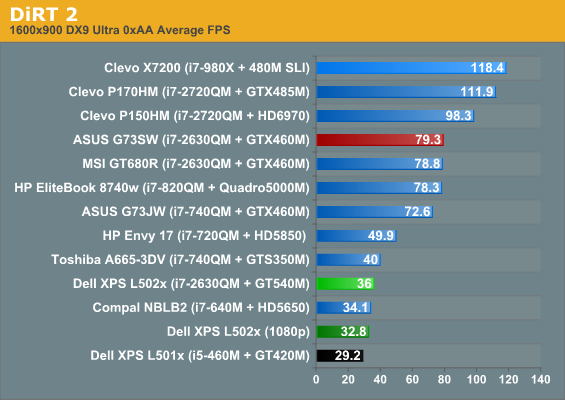

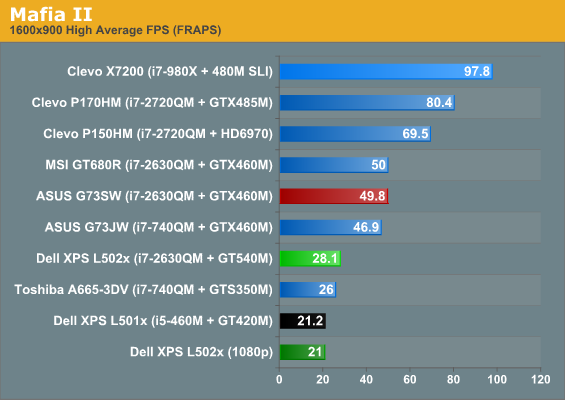

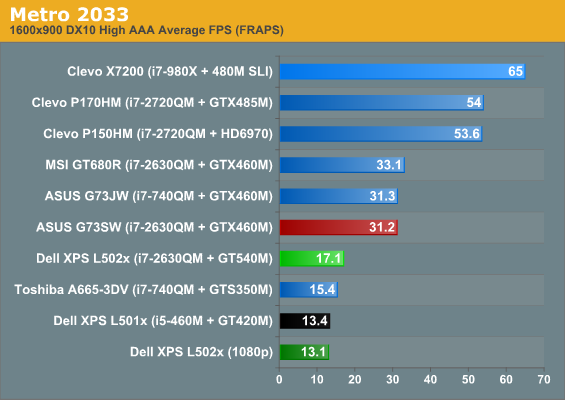
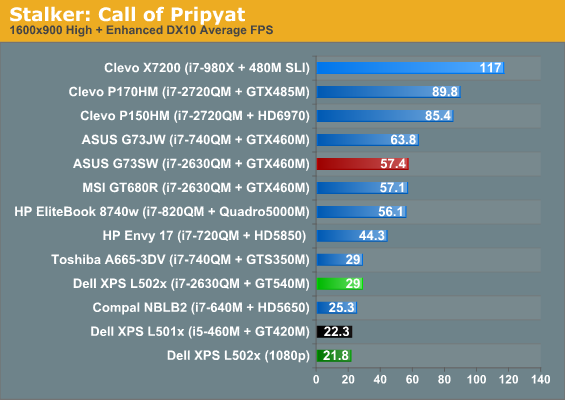
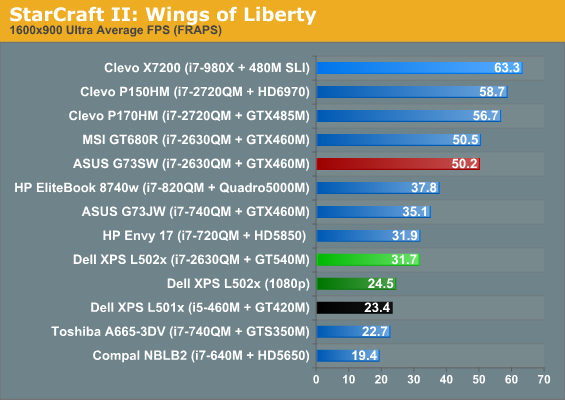
Looking at the charts and comparing the L501x with the L502x, the CPU actually appears to be a significant bottleneck at lower quality settings. That starts to go away once we move to medium quality and is largely gone at high quality, and there’s still the question of driver differences. The L502x is 31 to 63% faster than the L501x at our low settings, 12 to 51% faster at medium, and 23-43% faster at high. In general, the L502x is able to handle low to medium detail at the native 1080p resolution; if you want to run at medium to high settings you’ll often have to lower the resolution.
Going back to the ASUS G73SW (GTX 460M) comparison once more, we don’t have results for at low quality on the 460M, but the gap at medium is 6 to 198%—with the small 6% lead coming in StarCraft II, a game that can be extremely CPU limited at lower detail settings. If we remove SC2 from the list, the lead is 49 to 98%, which is more in line with what you’d expect from the GPU differences. At high detail, the lead grows to 58 to 120%—again with SC2 being the smallest difference, though L4D2 is similar in that it’s only a 60% lead for the 460M. So how does a GPU that’s got twice the computational performance and slightly more than double the bandwidth end up 120% faster in some games? The 540M in the XPS 15 comes with 2GB RAM versus 1.5GB in the G73SW, so that’s not the explanation. The likely culprit is Optimus, which can have a bit of a PCIe bandwidth bottleneck at times, though it’s possible there’s just something peculiar in how DiRT 2 does things.
If you’re after a good all-around laptop that can handle most games, the new XPS 15 improves on the old model but it’s often not a big enough change to allow you to run at native resolution with higher quality settings. What it does provide is a smoother experience at reasonable settings. The L501x could hit 30 FPS at 1080p and medium detail in three of our eight test games and the L502x breaks 30FPS with the same settings in five games (Mafia II, Mass Effect 2, and Metro 2033 being the exceptions). At our 900p High defaults, the L501x couldn’t break 30FPS in any of the games, but the L502x gets half the games (DiRT 2, Left 4 Dead 2, Mass Effect 2, and STALKER) above our “minimum desired performance” threshold. Dedicated laptop gamers however will still want more.
We’re still waiting to see where the GT 555M falls in terms of performance, but it should slot in nicely between the 540M and the significantly faster GTX offerings. All of the 540M and lower GPUs get saddled with the same 128-bit memory interface, and without GDDR5 to increase bandwidth there’s a significant bottleneck when you start increasing resolution. GDDR5 unfortunately is power hungry, so for the time being most mobile GPUs are saving it for their high-end SKUs where battery life isn’t a concern. Outside of the GTX line, the GT 555M is one of the few NVIDIA mobile GPUs where you can find GDDR5—and there’s some weird changes in the core and memory interfaces for the two 555M models.
The GT 555M version with GDDR5 uses a 128-bit bus and comes with the same 96 CUDA cores as the 540M, but they’re clocked 12% higher. That means you get 12% more computational performance but 74% more bandwidth compared to the GPU in our L502x. The 192-bit DDR3 version of the 555M has slightly less bandwidth, but it has 144 CUDA cores and accounting for clock speeds it has 17.5% more computational performance than the GDDR5 model—and 32% more computational performance than the 540M. It has less bandwidth than the GDDR5 model, even with a 192-bit memory interface, but still 50% more than the 540M. It looks like the new Alienware M14x will use the 192-bit DDR3 version of the GT 555M, which means gaming performance should be around 40-50% faster than the XPS L502x, and coupled with a 900p LCD upgrade the GT 555M should be just about right for our “High” gaming settings.










76 Comments
View All Comments
tno - Wednesday, April 20, 2011 - link
This review certainly gives us a peek at what the M11x R3 review will look like. Really hope to see some awesome battery numbers out of that.Jason
JarredWalton - Wednesday, April 20, 2011 - link
My experience is that Alienware laptops are never quite as optimized for maximum battery life. They have all the extra glowing lights on the case (which can usually be turned off, sure), and there's a bigger focus on performance. Dell is quoting "up to 6 hours" on the M14x, for instance, using a 63Wh battery. That's not so great, considering I've reached 6-7 hours with a 56Wh battery on the ASUS K53E with a 15.6" LCD. Anyway, I suspect the M11x R3 and M14x will be similar to the XPS 15 56Wh in battery life, which is good but not exceptional.GeorgeH - Wednesday, April 20, 2011 - link
At ~$1500 this isn't such a great laptop, but who pays MSRP for a Dell? You can pick a 2630QM/525M/1080p right now for ~$950 (some Deals are Slick-er than others... )I understand MSRP has to be used in a review analysis, though.
Jovec - Wednesday, April 20, 2011 - link
Yes, I've got an XPS 17 gen2 with a 2630, 1080p, 90w battery, backlit keyboard, and the 555 gpu for upgrades for just under $1200 with tax and shipping.JarredWalton - Thursday, April 21, 2011 - link
All of the little extras can quickly add up. The review sample upgraded the wireless to the Intel 6230 with Bluetooth ($35 extra), the battery to a 9-cell ($40 extra), 8GB RAM ($60 more than 6GB), GT 540M 2GB with TV tuner ($150), and adds in the backlit keyboard ($40).Of course, even with all of that, prices change regularly. Right now, if you start at the $1100 model, you can get all of the upgrades above and you end up at the $1425 price I quoted. Can you get most of what we tested for less? Sure. The XPS 15 and 17 also have different pricing. If you got the 17 with GT 555M and the various other upgrades for $1200, that's a very good price. At the Dell site, you're looking at around $1450 for all of the typical upgrades you listed (plus 8GB RAM).
Drag0nFire - Wednesday, April 20, 2011 - link
"it’s very difficult to point to a laptop that offers the build quality I want without a massive price premium."Any chance you're going to get one of the new Thinkpads in the lab any time soon? I'm hoping the T520 will fulfill the role you outlined at a reasonable price, as I'm in the market for a new laptop...
JarredWalton - Wednesday, April 20, 2011 - link
ThinkPads aren't exactly inexpensive. Yes, great build quality, but right now it looks like you get a bit less than the competition for your dollar.It's around $935 for an i5-2410M with 4GB RAM, 320GB HDD, integrated graphics, and a 1366x768 LCD. By comparison, the K53E will give you a larger HDD with the other parts being the same for $720.
Move up to around $1300 and you get a T520 with a dual-core i5-2540M, 4GB RAM, 500GB HDD, Quadro NVS 4200M, and a 1600x900 LCD. The XPS 15 can be had with 2630QM, GT 525M, 6GB RAM, 750GB HDD, and the 1080p LCD for just $1000 (so lose the Blu-ray, upgraded GPU, backlit keyboard, and upgraded WiFi of the system we reviewed).
I'm not saying the ThinkPad is a bad choice, but LCD quality is probably lousy (but at least matte) on everything short of the ThinkPad W-series, and pricing is higher than consumer notebooks. If I were buying a laptop for long-term use, though, I'd push the Latitude, ThinkPad T-series, and HP EliteBook up to the top of my list simply for the build quality.
JJG - Wednesday, April 20, 2011 - link
The pre-configured W520 with an i7 2720QM isn't much more than the XPS 15 you reviewed in this article. They run a little more than $1500 at many online retailers (with 8GB RAM, Nvidia Quadro 1000M, and a full HD screen). The 1920X1080 screen on the Lenovo is by some accounts as good as the one on the Dell. I would love to see you test that one, because I imagine the build quality is better and I think your reviews are among the most thorough on the net.JarredWalton - Wednesday, April 20, 2011 - link
You're right... that one looks like the sweet spot. Big question is if the 1080p panel is still a good one, or if they've shifted to a cheaper option. Only problem is getting Lenovo to send us anything for review. :-(headbox - Wednesday, April 20, 2011 - link
"XPS 15 L502x" doesn't exactly roll off the tongue. Why don't any PeeCee makers get this? Want to generate hype? Give your product a NAME.